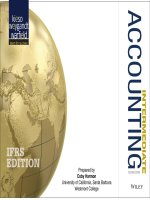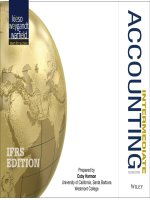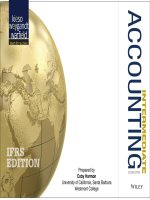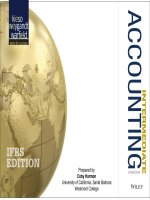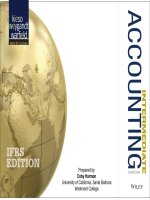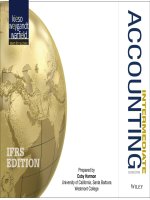Lecture Intermediate accounting (IFRS 2nd edition): Chapter 3 - Kieso, Weygandt, Warfield
Bạn đang xem bản rút gọn của tài liệu. Xem và tải ngay bản đầy đủ của tài liệu tại đây (3.23 MB, 125 trang )
3-1
PREVIEW OF CHAPTER
3
Intermediate Accounting
IFRS 2nd Edition
Kieso, Weygandt, and Warfield
3-2
3
The Accounting
Information System
LEARNING OBJECTIVES
After studying this chapter, you should be able to:
1. Understand basic accounting
terminology.
2. Explain doubleentry rules.
7.
3. Identify steps in the accounting cycle.
8.
4. Record transactions in journals, post to ledger
accounts, and prepare a trial balance.
5. Explain the reasons for preparing adjusting
entries.
3-3
6.
Prepare financial statements from the
adjusted trial balance.
Prepare closing entries.
Prepare financial statements for a
merchandising company.
ACCOUNTING INFORMATION SYSTEM
Accounting Information System (AIS)
3-4
u
Collects and processes transaction data.
u
Disseminates financial information to interested parties.
u
Varies widely from business to business.
►
Nature of business
►
Type of transactions
►
Size of business
►
Volume of data
►
Informational demands
LO 1
ACCOUNTING INFORMATION SYSTEM
Helps management answer such questions as:
3-5
u
How much and what kind of debt is outstanding?
u
Were our sales higher this period than last?
u
What assets do we have?
u
What were our cash inflows and outflows?
u
Did we make a profit last period?
u
Are any of our product lines or divisions operating at a loss?
u
Can we safely increase our dividends to shareholders?
u
Is our rate of return on net assets increasing?
LO 1
ACCOUNTING INFORMATION SYSTEM
Basic Terminology
3-6
u
Event
u
Journal
u
Transaction
u
Posting
u
Account
u
Trial Balance
u
Real Account
u
Adjusting Entries
u
Nominal Account
u
Financial Statements
u
Ledger
u
Closing Entries
LO 1
3
The Accounting
Information System
LEARNING OBJECTIVES
After studying this chapter, you should be able to:
1. Understand basic accounting terminology.
6.
2. Explain doubleentry rules.
3. Identify steps in the accounting cycle.
4. Record transactions in journals, post to ledger
accounts, and prepare a trial balance.
5. Explain the reasons for preparing adjusting
entries.
3-7
7.
8.
Prepare financial statements from the
adjusted trial balance.
Prepare closing entries.
Prepare financial statements for a
merchandising company.
ACCOUNTING INFORMATION SYSTEM
Debits and Credits
uAn account shows the effect of transactions on a given
asset, liability, equity, revenue, or expense account.
uDoubleentry accounting system (twosided effect).
uRecording done by debiting at least one account and
crediting another.
uDEBITS must equal CREDITS.
3-8
LO 2
Debits and Credits
Account
uAn arrangement that shows the
effect of transactions on an
account.
uDebit = “Left”
uCredit = “Right”
An Account can
be illustrated in a
TAccount form.
3-9
Account Name
Debit / Dr.
Credit / Cr.
LO 2
Debits and Credits
If the sum of Debit entries are greater than the sum of
Credit entries, the account will have a debit balance.
Account Name
Debit / Dr.
Credit / Cr.
Transaction #1
$10,000
$3,000
Transaction #3
8,000
Balance
3-10
Transaction #2
$15,000
LO 2
Debits and Credits
If the sum of Credit entries are greater than the sum of
Debit entries, the account will have a credit balance.
Account Name
Transaction #1
Balance
3-11
Debit / Dr.
Credit / Cr.
$10,000
$3,000
Transaction #2
8,000
Transaction #3
$1,000
LO 2
Debits and Credits Summary
Liabilities
Normal
Balance
Debit
Normal
Balance
Credit
Normal Balance
Equity
Credit / Cr.
Debit / Dr.
Normal Balance
Chapter
3-23
Credit / Cr.
Normal Balance
Expense
Debit / Dr.
Chapter
3-25
Revenue
Debit / Dr.
Credit / Cr.
3-12
Credit / Cr.
Normal Balance
Normal Balance
Chapter
3-27
Credit / Cr.
Chapter
3-24
Assets
Debit / Dr.
Debit / Dr.
Chapter
3-26
LO 2
Debits and Credits Summary
Statement of Financial
Position
Asset
= Liability + Equity
Income Statement
Revenue Expense
Debit
Credit
3-13
LO 2
The Accounting Equation
Relationship among the assets, liabilities and equity of a
ILLUSTRATION 33
business:
Expanded Equation and
Debit/Credit Rules and Effects
The equation must be in balance after every transaction.
For every Debit there must be a Credit.
3-14
LO 2
DoubleEntry System Illustration
1.
Owners invest $40,000 in exchange for ordinary shares.
Assets
+ 40,000
3-15
=
Liabilities
+
Equity
+ 40,000
LO 2
DoubleEntry System Illustration
2.
Disburse $600 cash for secretarial wages.
Assets
600
3-16
=
Liabilities
+
Equity
600
(expense)
LO 2
DoubleEntry System Illustration
3.
Purchase office equipment priced at $5,200, giving a 10 percent
promissory note in exchange.
Assets
+ 5,200
3-17
=
Liabilities
+
Equity
+ 5,200
LO 2
DoubleEntry System Illustration
4.
Received $4,000 cash for services performed.
Assets
+ 4,000
3-18
=
Liabilities
+
Equity
+ 4,000
(revenue)
LO 2
DoubleEntry System Illustration
5.
Pay off a shortterm liability of $7,000.
Assets
7,000
3-19
=
Liabilities
+
Equity
7,000
LO 2
DoubleEntry System Illustration
6.
Declared a cash dividend of $5,000.
Assets
=
Liabilities
+ 5,000
3-20
+
Equity
5,000
LO 2
DoubleEntry System Illustration
7.
Convert a noncurrent liability of $80,000 into ordinary shares.
Assets
=
Liabilities
80,000
3-21
+
Equity
+ 80,000
LO 2
DoubleEntry System Illustration
8.
Pay cash of $16,000 for a delivery van.
Assets
=
Liabilities
+
Equity
16,000
+ 16,000
Note that the accounting equation equality is
maintained after recording each transaction.
3-22
LO 2
Financial Statements and Ownership Structure
Ownership structure dictates the types of accounts that are
part of the equity section.
Proprietorship or
Partnership
3-23
Corporation
l
Capital account
l
Share capital
l
Drawing account
l
Share premium
l
Dividends
l
Retained Earnings
LO 2
ILLUSTRATION 34
Financial Statements and
Ownership Structure
Investments by shareholders
Net income retained in the
business
Financial
Statements
and Ownership
Structure
3-24
LO 2
Financial Statements and Ownership Structure
ILLUSTRATION 35
Effects of Transactions
on Equity Accounts
3-25
LO 2


